By Ana Rodriguez Soto - The Archdiocese of Miami
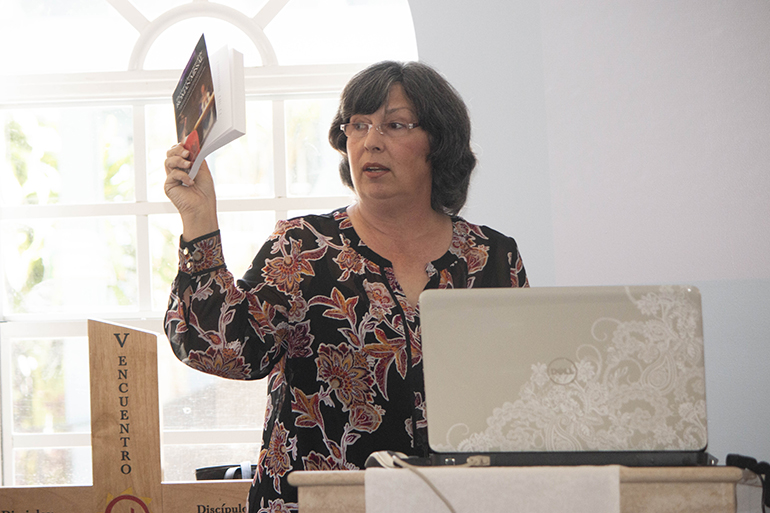
Photographer: ANA RODRIGUEZ-SOTO | FC
Maria Perez-Rudisill, director of music at St. Matthew Church, Hallandale, holds up a copy of the General Instruction on the Roman Missal, the official guide for celebrating the Mass, during her workshop in English at the Office of Lay Ministry's annual Enrichment Day. She spoke on "Music in liturgical celebrations." More than 500 people gathered at the Southeast Pastoral Institute April 27, 2019, for the Lay Ministry Office's annual Enrichment Day, presented this year in collaboration with the Office of Worship.
MIAMI | We repeat the words at every Mass: The Body of Christ. Amen. But do we know what those words require of us?
Speakers at the annual Enrichment Day for lay ministers delved into the depths of meaning, the power of the symbols and the layers of tradition that should make the Mass a transformative experience for every Catholic.
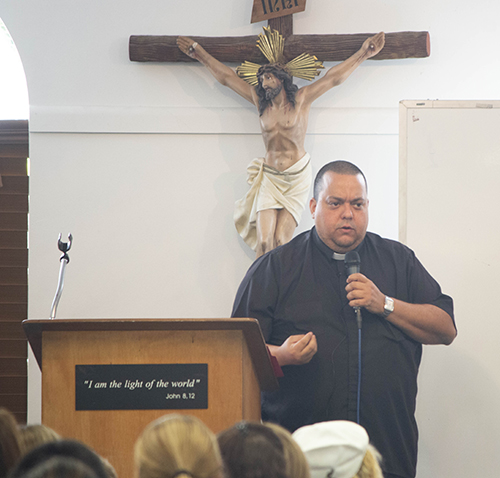
Photographer: ANA RODRIGUEZ-SOTO | FC
Salesian Father Julio Fernandez-Triana, currently parochial vicar at St. Kevin Church, Miami, leads the first workshop in Spanish at the Office of Lay Ministry's annual Enrichment Day. He spoke on "Liturgy, the art of celebrating the faith of the Church." He stressed that "it's important to know the meaning of what we do."
The bilingual event, entitled “Liturgy, the art of celebrating the faith of the Church,” drew more than 500 people — twice as many as expected — to the campus of SEPI, the Southeast Pastoral Institute, April 27.
That attendance denotes “the huge desire to learn more about our faith,” said Fiordaliza Ramirez, assistant in the Office of Lay Ministry, which teamed up with the Office of Worship to host the event.
The annual Enrichment Day is mandatory for all those enrolled in the two-year School of Ministry and optional for graduates and guests. But, Ramirez said, “We never had these many people.”
Speakers included past directors and staff of the Office of Worship: Msgr. Terence Hogan, currently pastor of Mary Help of Christians in Parkland; Father Juan Sosa, currently pastor of St. Joseph on Miami Beach; Rogelio Zelada, currently associate director for Hispanic formation in the Lay Ministry Office; and Maria Perez-Rudisill, currently music director at St. Matthew Church, Hallandale; as well as Salesian Father Julio Fernandez-Triana, a priest from Cuba currently serving as parochial vicar at St. Kevin Church, Miami.
“It’s important to know the meaning of what we do. Why we do what we do,” said Father Fernandez-Triana in his Spanish-language talk. “The liturgy, without theology, without history, is simply symbolic.”
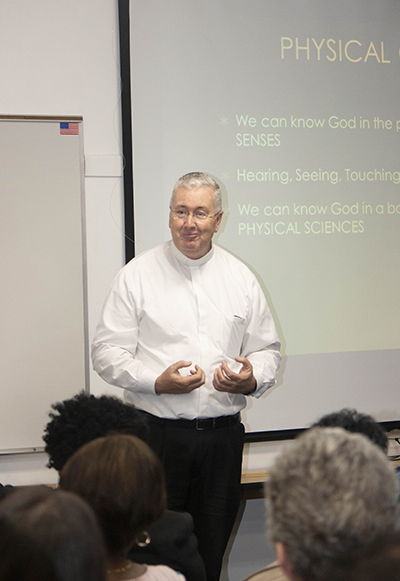
Photographer: ANA RODRIGUEZ-SOTO | FC
Msgr. Terence Hogan, former director of the Office of Worship and currently pastor of Mary Help of Christians in Parkland, leads the first workshop in English at the Office of Lay Ministry's annual Enrichment Day. He spoke on "Liturgy, the art of celebrating the faith of the Church," stressing that, during Mass, "the Holy Spirit is breathed in us and we go out and breathe that Spirit into the world."
And that is not at all correct, said Msgr. Hogan in his English-language presentation. He situated the Mass as the modern manifestation of God in salvation history, which began with Abraham and continues in today’s post-resurrection, “pentecostal” times. Pentecostal because of what Christ told the disciples: “I will send you the Holy Spirit and you will be the Church.”
“In the liturgy, we begin to understand how God shares himself,” Msgr. Hogan said.
Early on, he revealed himself to the Jewish people as the Word: a voice heard but not seen by Abraham and Moses. Then he revealed himself through Jesus, the Word made flesh, the perfect “lamb of God who takes away the sins of the world.”
Both those elements are present in the Mass, which consists of the liturgy of the word and the liturgy of the Eucharist. Catholics believe that, through that Mass, God continues to reveal himself and continues to save the world.
How? “Through us,” Msgr. Hogan said, because through our participation in the Mass we are “conformed to Christ. God’s Spirit is bequeathed on us.”
For Catholics, bread and wine are not just “a nice sentimental remembrance” of what Jesus did.
“We believe that through this Church, through this Holy Spirit, these symbols take on our means of salvation,” Msgr. Hogan said. The bread and wine become Christ’s Body and Blood and “we participate in a real way, here and now,” in Christ’s death and resurrection.
“The Holy Spirit is breathed in us and we go out and breathe that Spirit into the world,” Msgr. Hogan said. “There is an inner transformation if we are open to it.” Unfortunately, too often “we take the liturgy for granted.”
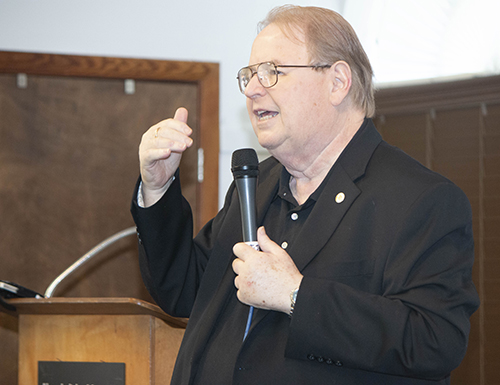
Photographer: ANA RODRIGUEZ-SOTO | FC
Rogelio Zelada, associate director for Hispanic formation in the Office of Lay Ministry, recounts "The history of the Mass: The living language of tradition," in his Spanish-language workshop at the annual Enrichment Day for lay ministers past, present and in formation.
Zelada picked up on that transformation while explaining how the Mass has changed over the centuries, from what Jesus did at the Last Supper to how the early Christians celebrated the Lord’s day to what we do today.
He stressed that the Body of Christ is not just the Eucharist, but also the person who receives it and the minister who distributes it. As such, receiving Communion “is an expression of commitment.”
Father Sosa’s talk focused on the Spanish translation of the Roman Missal which was approved for use in the U.S. last November. He noted that it was 30 years in the making and unique to the U.S.
“The national feast of each country is a liturgical feast here,” Father Sosa said, a unique reflection of the diversity of the Hispanics in the U.S.
In her talk, Perez-Rudisill focused on the role of music in the liturgy, noting the difference between sacred and liturgical music. “Not everything that is sacred is liturgical,” she said.
“Music just enhances what is going on at the altar and that is what it’s meant to do,” she stressed. Liturgical musicians “are servants of the liturgy. We’re not there to put on a show.”
Jose Ramiro Lopez, a lay minister from St. Timothy Church in Miami, remarked at the end that he was “more than satisfied” with what he had learned that day. “If you get nothing out of this,” he said, “you’re dead.”
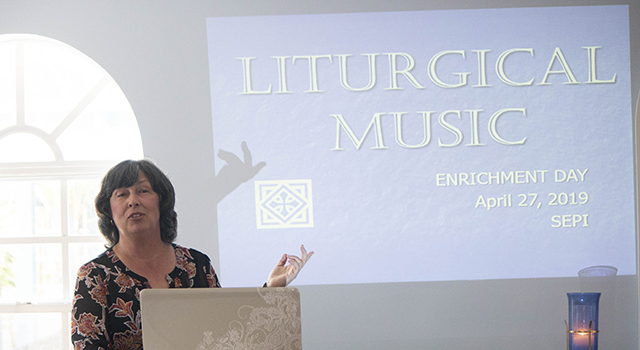

Comments from readers